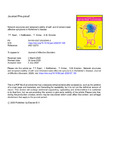Network structures and temporal stability of self- and informant-rated affective symptoms in Alzheimer's disease

Files
Self archived version
final draftDate
2020Author(s)
Unique identifier
10.1016/j.jad.2020.07.100Metadata
Show full item recordMore information
Self-archived item
Citation
Saari, TT. Hallikainen, I. Hintsa, T. Koivisto, AM. (2020). Network structures and temporal stability of self- and informant-rated affective symptoms in Alzheimer's disease. Journal of affective disorders, 276, 1084-1092. 10.1016/j.jad.2020.07.100.Rights
Abstract
Background
Affective symptoms in Alzheimer's disease (AD) can be rated with both informant- and self-ratings. Information from these two modalities may not converge. We estimated network structures of affective symptoms in AD with both rating modalities and assessed the longitudinal stability of the networks.
Methods
Network analyses combining self-rated and informant-rated affective symptoms were conducted in 3198 individuals with AD at two time points (mean follow-up 387 days), drawn from the NACC database. Self-rated symptoms were assessed by Geriatric Depression Scale, and informant-rated symptoms included depression, apathy and anxiety questions from Neuropsychiatric Inventory Questionnaire.
Results
Informant-rated symptoms were mainly connected to symptoms expressing lack of positive affect, but not to the more central symptoms of self-rated worthlessness and helplessness. Networks did not differ in structure (p = .71), or connectivity (p = .92) between visits. Symptoms formed four clinically meaningful clusters of depressive symptoms and decline, lack of positive affect, informant-rated apathy and anxiety and informant-rated depression.
Limitations
The symptom dynamics in our study could have been present before AD diagnosis. The lack of positive affect cluster may represent a methodological artefact rather than a theoretically meaningful subgroup. Requiring follow-up lead to a selection of patients with less cognitive decline.
Conclusions
Informant rating may only capture the more visible affective symptoms, such as not being in good spirits, instead of more central and severe symptoms, such as hopelessness and worthlessness. Future research should continue to be mindful of differences between self- and informant-rated symptoms even in earlier stages of AD.
Link to the original item
http://dx.doi.org/10.1016/j.jad.2020.07.100Publisher
Elsevier BVCollections
- Filosofinen tiedekunta [463]


